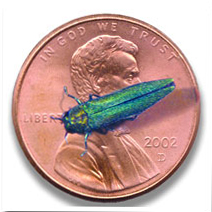POSTED BY Emily O’Toole
Article I Section 8 of The United States Constitution provides Congress with the authority to regulate and coin money in Clause 5. Clause 6 also grants Congress the authority to punish those that create counterfeit money. The ability to punish counterfeiters, however, is contingent on the ability to catch counterfeiters. A key component to catching counterfeiters is the ability to even tell that the bills in questions are invalid.
The United States has a long history of combatting counterfeit currency by using innovations in printing technology. Prior to attaining independence, Ben Franklin was printing colonial bills that had raised three-dimensional patterns based on leaf impressions in an effort to thwart counterfeiters. After the United States gained independence, there were a plethora of issues in money production. By 1860, one third of currency in the United States was counterfeit. By 1862, to combat the vast amount of counterfeit bills, the design of money became more intricate with the use of fine line engraving, lathe designs, treasury seals, and engraved signatures. Another big change to the money printing process was in the 1990s when micro printed words and a polyester security thread, only visible when held up to the light, were added to US currency. The fraud prevention measures incorporating new technologies seem to have had some success because as of 2004 less than .01% of US currency was counterfeit. Today, ten years later, counterfeiting may be on the rise again because technological innovation is helping the counterfeiters as well as the government. The easy availability of constantly improving inkjet printing, scanning, and copying technology creates a possibility for a large breadth of the population to design passable counterfeit bills.
However, a new technology in printing may be just in time to stop the rise in counterfeiting. The ink is inspired by a color changing longhorn beetle. The beetle’s wings change in color from gold, when dry, and from red, when wet, because of how the scales in the beetle’s wings reflect light. This color changing ink uses colloidal photonic crystals that change color when exposed to ethanol vapors. The designers can decide the exact shade of the original color and the secondary color exposed by the ethanol vapors. The big selling point of this ink is that this new process is much cheaper, faster and easier than that of past technology using the same crystals. It can be applied quickly on hard and durable surfaces, it will not fade after long exposure to light, and the exact colors chosen should be difficult to mimic.
This technology does sound promising, and will most likely cut down on small time counterfeiting operations. If larger scale counterfeiters can get their hands on the ink, or hire a scientist, they may be able to duplicate US currency with the same designs and printers they already use. Still, it is probably a good idea for the US government to look into this new technology and weigh the potential benefits. Will they use it? Will it help? Only time will tell, but I will be on the lookout.
Bio: Emily is currently a 2L staff member on the Journal of High Technology Law at Suffolk University Law School. She has a Bachelor’s Degree from Fairfield University, and she hopes to work in public interest upon graduation from Suffolk Law.


You must be logged in to post a comment.